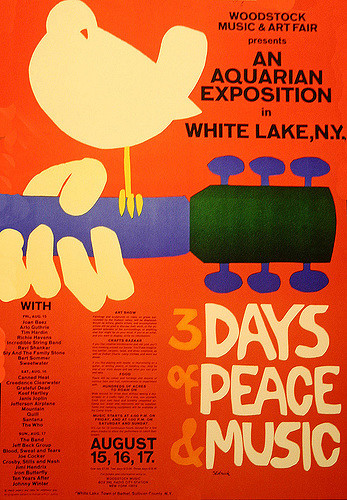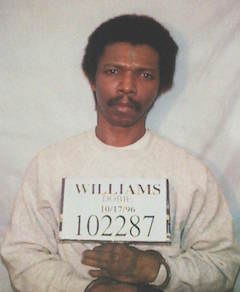The Sixties. We think of the Vietnam War, Civil Rights protests, the assassination of John F. Kennedy, the Apollo landing on the moon, hippies, Peace on Earth, and most importantly, the music. Music is how famous musicians express their thoughts and feelings to a broader audience.1 The Sixties made history through its music and more iconically, through a three-day concert known as Woodstock.

It all started with four young men that wanted to build a recording studio: John Roberts, 26-years-old, and an heir to a drugstore and a multi-million dollar trust fund; Joel Rosenman, 24-years-old, a Yale Law School graduate, and guitar player for a lounge band in Long Island and Las Vegas hotels; Artie Kornfeld, 25-years-old, a songwriter, producer, and the vice president of Capitol Records; and finally, Michael Lang, 23-years-old, and owner of a head shop that sold accessories for weed, tobacco, and other recreational drugs in Florida.2 All four men met in February of 1969 and came up with the idea of creating a rock festival, and they discussed the budget for it. They met several times after to discuss other ideas for the festival. And by their last meeting, they had a budget of five hundred thousand dollars, and were hoping for fifty thousand people to attend. Unknowingly, their “Woodstock” would become the world’s largest and most remembered Rock concert of all time.

In March of 1969, the four young men formed the Woodstock Ventures company, and each man held a twenty-five percent stake in it.3 The team now needed a location for the concert; they decided to hold the concert in a three hundred acre dairy farm in Bethel, New York, because it offered easy access from New York City, less than a mile from Route 17. And it offered electricity and water lines.4 They paid seventy five thousand dollars for the rental of the property to Max Yasgur, the owner.5 By April, Kornfeld and Lang wanted to advertise and introduce Woodstock as a place of freedom with music. They had promoters create a Woodstock image for the public. The group came up with the slogan “Three Days of Peace and Music,” because they figured, if people read “peace” in the poster, it would keep the public calm and the event free of violence. The group then hired artist Arnold Skolnick to create the image for a poster. What people thought was originally a dove on the Woodstock poster was actually a catbird, which was one of Arnold’s favorite things to draw. When Arnold finally completed the drawing for the Woodstock poster, it featured a catbird sitting on a flute along with the slogan, “Three Days of Peace and Music.” This design was approved by Woodstock Ventures. However, at the last minute, Arnold made a minor change by having the catbird stand on a guitar instead of the flute, and the poster was completed.6
Woodstock Ventures wanted the most popular rock’n’roll bands to perform at the concert. They composed contracts for each band member attending, which came with promising paychecks. They signed Jefferson Airplane for twelve thousand dollars, Creedence Clearwater Revival for eleven thousand five hundred dollars, and The Who for twelve thousand five hundred dollars.3 They had a total of thirty-two bands listed to play, including Janis Joplin, The Grateful Dead, Joe Cocker, Crosby, Stills, Nash and Young, and others. The highest paid performer was Jimi Hendrix, who signed for thirty-two thousand dollars. Hendrix would be the last act to perform and he famously closed the festival with his version of the “Star Spangled Banner,” which has gone down in history as one of the greatest performances of his career.8 Woodstock Ventures paid a total of one hundred and eighty thousand dollars for all the musicians who performed in the concert. Lang made the decision that he did not care what it would cost to get a rock band to perform for Woodstock. They would pay the deposit and create the contracts at whatever cost to ensure that they had the best performers.
By the spring time, advertisements for Woodstock started appearing in the New York Times and on radio stations across the country.9 While Woodstock Ventures had originally expected fifty thousand people to attend the festival, they sold a total of one hundred and eighty six thousand tickets, costing six dollars per day.10 In August, one week before show time, Kornfeld wanted to capture the stories of the people, their thoughts about Vietnam War, and their thoughts about Woodstock. Kornfeld made an offer with Warner Brothers to document the festival. Woodstock Ventures paid one hundred thousand dollars to have the festival filmed, and a contract was signed agreeing that if the film made it big they would get paid double the amount, and if it failed they would get nothing.
On August 14, 1969, the day before the festival, early in the morning, Woodstock Ventures noticed that traffic was backed up ten miles long on Route 17, and they were shocked to see that so many people were attending. An estimated twenty five thousand people were already waiting before the festival began.11 The four young men knew this concert was going to be amazing, but they never thought that it would go down in history as one of the biggest and “the greatest peaceful events in history,” as Time magazine called it.12

Throughout the years many attempts to recreate another Woodstock have failed. The Woodstock of 1969 will forever go down in history for its great music, the psychedelic people, and most importantly, a once in a lifetime event that can never be forgotten.
- Alan Brinkley, American History: Connecting with the Past Volume 2 (New York: McGraw-Hill Education, 2014), 812-813. ↵
- “How Woodstock Happened,” reprinted from The Times Herald-Record, 1994. http://www.edjusticeonline.com/woodstock/history/index.htm. (accessed November 17, 2016). ↵
- “How Woodstock Happened,” reprinted from The Times Herald-Record, 1994. http://www.edjusticeonline.com/woodstock/history/index.htm. (accessed November 17, 2016). ↵
- “Woodstock Music Festival.” History.com, 2009, http://www.history.com/this-day-in-history/woodstock-music-festival-concludes. (accessed November 10, 2016). ↵
- “How Woodstock Happened,” The Times Herald-Record Woodstock Commemorative Edition, 1994, http://www.edjusticeonline.com/woodstock/history/index.htm. (accessed November 17, 2016). ↵
- “How Woodstock Happened,” The Times Herald-Record Woodstock Commemorative Edition, 1994, http://www.edjusticeonline.com/woodstock/history/index.htm. (accessed November 17, 2016). ↵
- “How Woodstock Happened,” reprinted from The Times Herald-Record, 1994. http://www.edjusticeonline.com/woodstock/history/index.htm. (accessed November 17, 2016). ↵
- Spencer Bright, “Forty far-out Facts you never knew about Woodstock,” Daily Mail, August 7 2009. ↵
- “How Woodstock Happened,” The Times Herald-Record Woodstock Commemorative Edition, 1994, http://www.edjusticeonline.com/woodstock/history/index.htm. (accessed November 17, 2016). ↵
- Daily Mail, August 2009, s.v. “Forty far-out Facts you never knew about Woodstock,” by Spencer Bright. ↵
- “How Woodstock Happened,” reprinted from The Times Herald-Record, 1994. http://www.edjusticeonline.com/woodstock/history/index.htm. (accessed November 17, 2016). ↵
- Daily Mail, August 2009, s.v. “Forty far-out Facts you never knew about Woodstock,” by Spencer Bright. ↵




75 comments
Andrew Gray
I’ve recently found myself browsing through Youtube videos which eventually led to a series of Woodstock documentaries and found it most interesting. I am now a big fan of the history of the concert but have even gone so far as to look up the myth stating that a child was birthed in the middle of the event. However, I never knew how much the bands were paid and I found that quite interesting that it was mentioned in the article. Great read!
Tyler Sleeter
Very informative article. I did not know much about Woodstock, except that it was a concert for the hippy generation. I found it interesting to see that so much went into the planning of the event including bringing all the musical talent to perform. I did not realize that the event was planned as a peace and music festival and that many people have attempted to duplicate the event over the years.
Cameron Adelman
Good article. Your use of imagery really stood out to me, especially the final picture depicting Woodstock’s opening ceremony and your featured image featuring the Woodstock festival poster. You did a great job detailing the event and how it came about, but I would have loved to here some insights regarding why this event was so unique from other rock concerts and why no one has been able to duplicate its success. Other then that, it was a good read.
Lianna Ybarra
I really liked this article! I didn’t know much about Woodstock except that it was a huge concert that was put on in the 60’s. I imagined it was a bunch of hippies but to know the background of this and how it came to be is so awesome. I think what really captured people was the “peace and music” because there had been so much going on in the world at the time.
Nahim Rancharan
The sixties was an important time period, especially in regards to industries like music. More specifically, Woodstock served as the stage in which music icons such as Jimi Hendrix and The Who could perform for their fans in an area in which there was nothing but peace. This article effectively captures the fact that the three-day Rock and Roll concert served as an area in which people form all across the nation could promote their ideas of Peace and Love, while enjoying excellent music; despite the harsh realities of the Vietnam War. For many, Woodstock served as a platform in which musicians and the public could share their ideas against the harshness of American Society during that time. There is not doubt that Woodstock is one of the greatest and most iconic festivals in music history. Job Well Done on the article!!!!
Gabriela Serrato
It was great to read about the back ground information that led to Woodstock. Woodstock is still so widely known today and it was nice to read just about how it came about. It was very interesting that this giant success came along from a simple idea from a few men. I was also very surprised to see the amount of money performers were paid to perform because I compared it to today’s singers who get paid millions for possibly one performance. It is interesting to see how much has changed from that period to modern day.
Priscilla Reyes
I loved learning about the men who ran such an amazing event! They were very creative with the slogan and killed two birds at once, I think! The place where the concert was held was also very thought out, although the amount of people attending exceeded their expectations! As you stated, it was a once in a lifetime thing due to the performers, and emotions at the time. Also, it was the first time such a thing occurred, and it was very successful because of the events motives.
Mario De Leon
This article is very interesting because it gives the background story to one of the most famous music festival. I did not know that the slogan, “Three Days of Peace and Music,” was intended to keep the public peaceful at the festival. I like how the article ended with noting that many other music festivals have tried to recreate what Woodstock had achieved but nobody has succeeded.
Jacob Hall
A very informative article detailing the genesis of one of the most iconic events in American 20th century history. Four young men with great resources and a grand, shared vision came together and in less than a year carried out the largest rock concert of all time, with some of the biggest name performers of all time, and an audience of over 186,000 people – in a peaceful manner. Still awe inspiring to this day.
Yesenia Cardenas
I do not know a lot about Woodstock except for references in popular culture. I cannot imagine how so many people showed up for a concert in a time way before social media.